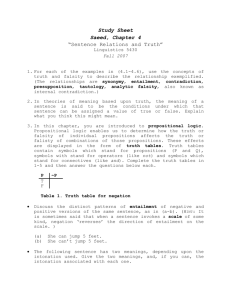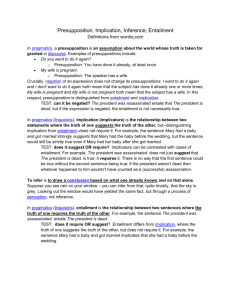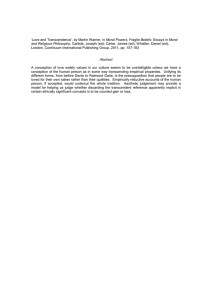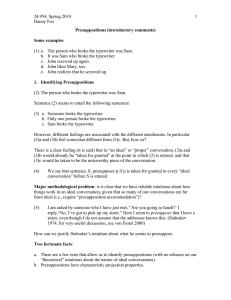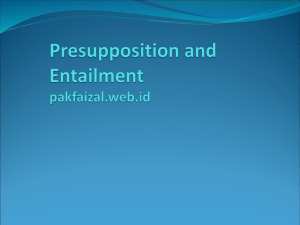Presuppositions and Entailments in Linguistics
advertisement
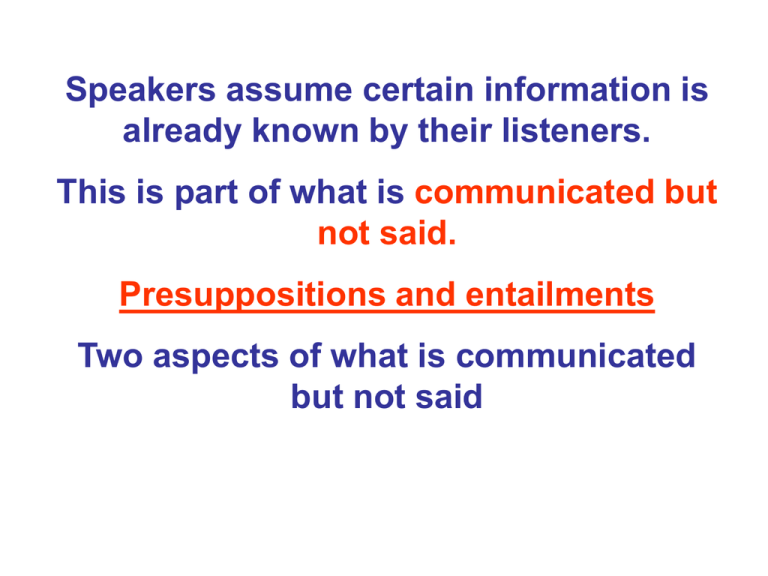
Speakers assume certain information is already known by their listeners. This is part of what is communicated but not said. Presuppositions and entailments Two aspects of what is communicated but not said Presupposition: The information that a speaker assumes to be already known. (The Cambridge Encyclopaedia of Language, 1987) Implicit meanings conveyed by the speaker through the use of particular words. Ex: "The Cold War has ended" presupposes that the existence of the entities it refers to, in this case the "Cold War". Speakers, not sentences, have presuppositions Entailment is not a pragmatic concept. It is defined as what logically follows from what is asserted in the utterance. Sentences, not speakers, have entailments. Speakers have presuppositions while sentences have entailments. Example: Susan’s sister bought two houses. This sentence presupposes that Susan exists and that she has a sister. This sentence has the entailments that Susan’s sister bought something; now she has 2 houses, a house, and other similar logical consequences. The entailments are communicated without being said and are not dependent on the speaker’s intention. Presupposition: The relationship between two propositions. Mary’s cat is cute. (p) Mary has a cat. (q) p >>q = p presupposes q If the speaker denies the proposition p (NOT p), the presupposition q doesn’t change. Mary’s cat isn’t cute. (NOT p) Mary has a cat. (q) Not p >>q = Not p presupposes q Presupposition: Constancy under negation: The presupposition of a statement will remain true even when that statement is negated. Presupposition: Other examples of constancy under negation: p: Dave is angry because Jim crashed the car. q: Jim crashed the car p >> q NOT p: Dave isn’t angry because Jim crashed the car q: Jim crashed the car NOT p >> q Presupposition: p: Mr. Singleton has resumed his habit of drinking stout q: Mr. Singleton had a habit of drinking stout. p >> q NOT p: Mr. Singleton hasn’t resumed his habit of drinking stout q: Mr. Singleton had a habit of drinking stout. NOT p >> q Types of Presupposition Presuppositions are associated with the use of a large number of words, phrases and structures. These linguistic forms are considered as indicators of potential presupposition, which can only become actual presupposition in contexts with speakers. 1- Existential presupposition: Entities named by the speaker and assumed to be present - noun phrase. - possessive constructions “David’s car is new” we can presuppose that David exists and that he has a car. Some lexical triggers: Definite noun phrases: The student fell asleep. The student didn’t fall asleep David is a bachelor (David is an unmarried male person) 2- Factive presupposition: identified by the presence of some verbs such as "know“, "realize“, “be glad”, “be sorry”, etc. Some lexical triggers: Factive verbs: 1. 2. 3. 4. Tracy realized Pat ate a sandwich. >> pat was ill Pat regretted eating a sandwich. >> we ate a snadwich Pat liked eating a sandwich. I was aware of the class cancellation on Monday>> the class was cancelled 5. I’m glad it’s over. >> it is over 6. She didn’t realize that she was ill >> she was ill. 3- Lexical presupposition: In using one word, the speaker can act as if another meaning will be understood. For instance: Mary stopped running. (>>She used to run.) You are late again. (>> You were late before.) Are you still such a bad driver? (>> You were a bad driver) "stop“, "again“ “still” are taken to presuppose another (unstated) concept. Some lexical triggers: Change of state verbs: Pat stopped eating a sandwich (at 2pm). Pat started eating a sandwich (at 2pm). Verbs of judgment: Tracy blamed Pat for eating the sandwich. Tracy faults Pat for eating the sandwich. Susan is accused of X (X is bad) Susan was criticized for X (X is bad and Susan did X) 4- Structural presupposition: it is the assumption associated with the use of certain structures. - wh-question constructions. When did she travel to the USA? ( >> she travelled) Where did you buy the book? (>> you bought the book) The listener perceives that the information presented is necessarily true, or intended as true by the speaker.. 5- Non- factive presupposition: it is an assumption referred to something that is not true. For example, verbs like "dream", "imagine" and "pretend" are used with the presupposition that what follows is not true. I dreamed that I was rich. (>> I was not rich) We imagined that we were in London. (>> We were not in London) 6- Counterfactual presupposition: it is the assumption that what is presupposed is not only untrue, but is the opposite of what is true, or contrary to facts. -conditional structures, If you were my daughter, I would not allow you to do this. ( >> you are not my daughter) If I were rich I would buy a Ferrari (>> I’m not rich) The projection problem In many cases presuppositions don’t survive to become the meaning of complex sentences. Why? They are “destroyed” by entailments The entailments are more powerful of presuppositions Examples: The unicorn is waiting in the garden. #Yet there are no unicorns. Pat knows that the unicorn is waiting in the garden. #Yet there are no unicorns. Entailment • sentences that stand in an implicational relation, where the truth of the first guarantees the truth of the second. – The anarchist assassinated the emperor. – The emperor died. • So, the first sentence entails the second. Entailment A: Everyone passed the examination. B : No-one failed the examination. A entails B – whenever A is true, B is true – the information that B contains is contained in the information that A conveys – a situation describable by A must also be a situation describable by B – A and NOT B are contradictory. We take entailment relations to be those that specifically arise from linguistic structure Generally speaking, entailment is not a pragmatic concept (i.e. having to do with the speaker meaning), but it is considered a purely logical concept. Ordered Entailments 1) Bob ate three sandwiches. a) Someone ate three sandwiches. (Who ate the sandwiches) b) Bob did something to three sandwiches. (What Bob did) c) Bob ate three of something. (What Bob ate) d)Something happened. (What happened) The speaker will necessarily produce a very large number of background entailments but the speaker will indicate how these entailments are to be ordered How? by stress by using special structures So The hearer will understand which entailment is assumed to be more important for interpreting intended meaning What is the foreground entailment? BOB ate three sandwiches. Bob ATE three sandwiches. Bob ate THREE sandwiches. Bob ate three SANDWICHES. It-cleft construction/cleft sentences: a) It was TOM that did the work. b) It wasn’t ME who took your jacket. Cleft sentences are used to help us focus on a particular part of the sentence and to emphasise what we want to say … Because there are two parts … they are called cleft (from the verb cleave) which means divided into two. Cleft sentences are particularly useful in writing where we cannot use intonation for purposes of focus or emphasis, but they are also frequently used in speech. Cleft structures include the reason why, the thing that, the person/people who, the place where, the day when and what-clauses which are usually linked to the clause that we want to focus on with is or was. From: BBC World service Examples of cleft sentences: I've come to discuss my future with you. The reason why I've come is to discuss my future with you. Your generosity impresses more than anything else. The thing that impresses me more than anything else is your generosity. The jewels are hidden under the floor at 23 Robin Hood Road, Epping. The place where the jewels are hidden is under the floor at 23 Robin Hood Road, Epping. Under the floor at 23 Robin Hood Road is the place where the jewels are hidden. Mary works harder than anybody else in this organisation. The person who works harder than anybody else in this organisation is Mary. Mary is the person in this organisation who works harder than anybody else. The Second World War ended on 7 May 1945 in Europe. The day (when) the Second World War ended in Europe was 7 May 1945 7 May 1945 was the day (when) the Second World War ended in Europe. We now need actions rather than words. What we now need are actions rather than words. Actions rather than words are what we now need. I enjoyed the brilliant music most of all in the Ballet Frankfurt performance. What I enjoyed most in the Ballet Frankfurt performance was the brilliant music. The brilliant music was what I enjoyed most in the Ballet Frankfurt performance. Presuppositions vs. entailments • Utterances and their presuppositions. 1) She has stopped smoking. presupposes She used to smoke. 2) My dog ate my bag. presupposes I have a dog, and I have (had) a bag. • Utterances and their entailments. The emperor was assassinated entails 1) Someone was assassinated. 2) The emperor died. Presuppositions vs. entailments • Presuppositions are different from entailments. 1) She hasn’t stopped smoking. Still presupposes She used to smoke. 2) My dog didn’t eat my bag. Still presupposes I have a dog, and I (still, it seems) have a bag. while The emperor wasn’t assassinated. Does not entail any more 1)Someone was assassinated. 2)The emperor died.
